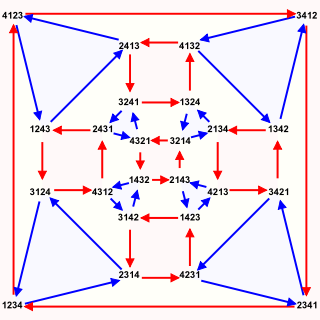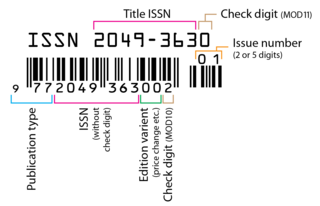
In abstract algebra, the symmetric group defined over any set is the group whose elements are all the bijections from the set to itself, and whose group operation is the composition of functions. In particular, the finite symmetric group Sn defined over a finite set of n symbols consists of the permutation operations that can be performed on the n symbols. Since there are n! possible permutation operations that can be performed on a tuple composed of n symbols, it follows that the number of elements of the symmetric group Sn is n!.
In mathematics, a generating function is a way of encoding an infinite sequence of numbers (an) by treating them as the coefficients of a power series. This formal power series is the generating function. Unlike an ordinary series, this formal series is allowed to diverge, meaning that the generating function is not always a true function and the "variable" is actually an indeterminate. Generating functions were first introduced by Abraham de Moivre in 1730, in order to solve the general linear recurrence problem. One can generalize to formal series in more than one indeterminate, to encode information about arrays of numbers indexed by several natural numbers.
In mathematics, the falling factorial is defined as the polynomial
In algebra, the partial fraction decomposition or partial fraction expansion of a rational function is an operation that consists of expressing the fraction as a sum of a polynomial and one or several fractions with a simpler denominator.

In combinatorics, the inclusion–exclusion principle is a counting technique which generalizes the familiar method of obtaining the number of elements in the union of two finite sets; symbolically expressed as
In mathematics, and in particular in group theory, a cyclic permutation is a permutation of the elements of some set X which maps the elements of some subset S of X to each other in a cyclic fashion, while fixing all other elements of X. If S has k elements, the cycle is called a k-cycle.
In mathematics, specifically in commutative algebra, the elementary symmetric polynomials are one type of basic building block for symmetric polynomials, in the sense that any symmetric polynomial can be expressed as a polynomial in elementary symmetric polynomials. That is, any symmetric polynomial P is given by an expression involving only additions and multiplication of constants and elementary symmetric polynomials. There is one elementary symmetric polynomial of degree d in n variables for each nonnegative integer d ≤ n, and it is formed by adding together all distinct products of d distinct variables.
In mathematics, a q-analog of a theorem, identity or expression is a generalization involving a new parameter q that returns the original theorem, identity or expression in the limit as q → 1. Typically, mathematicians are interested in q-analogs that arise naturally, rather than in arbitrarily contriving q-analogs of known results. The earliest q-analog studied in detail is the basic hypergeometric series, which was introduced in the 19th century.
In combinatorics, the Eulerian numberA(n, m), is the number of permutations of the numbers 1 to n in which exactly m elements are greater than the previous element. They are the coefficients of the Eulerian polynomials:
The Stanley–Wilf conjecture, formulated independently by Richard P. Stanley and Herbert Wilf in the late 1980s, states that the growth rate of every proper permutation class is singly exponential. It was proved by Adam Marcus and Gábor Tardos (2004) and is no longer a conjecture. Marcus and Tardos actually proved a different conjecture, due to Zoltán Füredi and Péter Hajnal (1992), which had been shown to imply the Stanley–Wilf conjecture by Klazar (2000).
In mathematics, specifically in commutative algebra, the power sum symmetric polynomials are a type of basic building block for symmetric polynomials, in the sense that every symmetric polynomial with rational coefficients can be expressed as a sum and difference of products of power sum symmetric polynomials with rational coefficients. However, not every symmetric polynomial with integral coefficients is generated by integral combinations of products of power-sum polynomials: they are a generating set over the rationals, but not over the integers.
In combinatorial mathematics, a rook polynomial is a generating polynomial of the number of ways to place non-attacking rooks on a board that looks like a checkerboard; that is, no two rooks may be in the same row or column. The board is any subset of the squares of a rectangular board with m rows and n columns; we think of it as the squares in which one is allowed to put a rook. The board is the ordinary chessboard if all squares are allowed and m = n = 8 and a chessboard of any size if all squares are allowed and m = n. The coefficient of x k in the rook polynomial RB(x) is the number of ways k rooks, none of which attacks another, can be arranged in the squares of B. The rooks are arranged in such a way that there is no pair of rooks in the same row or column. In this sense, an arrangement is the positioning of rooks on a static, immovable board; the arrangement will not be different if the board is rotated or reflected while keeping the squares stationary. The polynomial also remains the same if rows are interchanged or columns are interchanged.
In mathematics, a symmetric tensor is a tensor that is invariant under a permutation of its vector arguments:
In combinatorial mathematics and theoretical computer science, a permutation pattern is a sub-permutation of a longer permutation. Any permutation may be written in one-line notation as a sequence of digits representing the result of applying the permutation to the digit sequence 123...; for instance the digit sequence 213 represents the permutation on three elements that swaps elements 1 and 2. If π and σ are two permutations represented in this way, then π is said to contain σ as a pattern if some subsequence of the digits of π has the same relative order as all of the digits of σ.
In algebra and in particular in algebraic combinatorics, a quasisymmetric function is any element in the ring of quasisymmetric functions which is in turn a subring of the formal power series ring with a countable number of variables. This ring generalizes the ring of symmetric functions. This ring can be realized as a specific limit of the rings of quasisymmetric polynomials in n variables, as n goes to infinity. This ring serves as universal structure in which relations between quasisymmetric polynomials can be expressed in a way independent of the number n of variables.
In mathematics, Schubert polynomials are generalizations of Schur polynomials that represent cohomology classes of Schubert cycles in flag varieties. They were introduced by Lascoux & Schützenberger (1982) and are named after Hermann Schubert.
In combinatorial mathematics, the hook-length formula is a formula for the number of standard Young tableaux whose shape is a given Young diagram. It has applications in diverse areas such as representation theory, probability, and algorithm analysis; for example, the problem of longest increasing subsequences.
Plethystic substitution is a shorthand notation for a common kind of substitution in the algebra of symmetric functions and that of symmetric polynomials. It is essentially basic substitution of variables, but allows for a change in the number of variables used.

In computing, a Digital Object Identifier orDOI is a persistent identifier or handle used to uniquely identify objects, standardized by the International Organization for Standardization (ISO). An implementation of the Handle System, DOIs are in wide use mainly to identify academic, professional, and government information, such as journal articles, research reports and data sets, and official publications though they also have been used to identify other types of information resources, such as commercial videos.

An International Standard Serial Number (ISSN) is an eight-digit serial number used to uniquely identify a serial publication, such as a magazine. The ISSN is especially helpful in distinguishing between serials with the same title. ISSN are used in ordering, cataloging, interlibrary loans, and other practices in connection with serial literature.
Mathematical Reviews is a journal published by the American Mathematical Society (AMS) that contains brief synopses, and in some cases evaluations, of many articles in mathematics, statistics, and theoretical computer science. The AMS also publishes an associated online bibliographic database called MathSciNet which contains an electronic version of Mathematical Reviews and additionally contains citation information for over 3.5 million items as of 2018.










